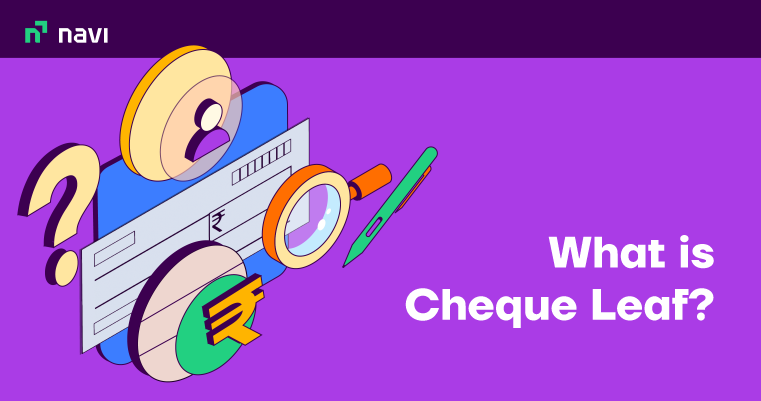What is Cheque Leaf – Purpose, Features and Types

Before the advent of electronic payment systems, bank cheques were the most popular form of non-cash payment. A single cheque in one’s chequebook is termed as a cheque leaf. Similarly, multiple cheques are called cheque leaves.
In this blog, we will discuss essential details of a cheque leaf, such as its purpose, features and the guidelines that payers/payees need to abide by.
What is a Cheque Leaf?
A single cheque from a chequebook is called a cheque leaf. You can use a cheque leaf to withdraw, deposit or transfer money from one account to another. Every cheque leaf instructs a bank or NBFC to pay the amount indicated in the cheque to the payee’s name mentioned on the cheque. The one who receives the money is called a Payee, the one who has written the cheque is the Drawer, and the Payee’s bank is called Drawee.
The payee and drawer could be an individual, bank, institution or even a business. Cheque leaves are vehicles for monetary exchange and are developed to enable smooth and easy financial transactions that are safe and secure.
What is the Purpose of a Cheque Leaf?
As mentioned above, a cheque is an instrument that allows you to transfer money from one account to another without physically handing over money. Cheques are majorly used as it is a safer alternative to in-hand handling of money. Additionally, transfers with cheque leaves help you to keep track of all your transactions.
There are different types of cheques that do different things. However, the transfer of money remains the point of commonality and purpose. Although it ensures complete no-cash transactions, most individuals have adopted digitization, where payments are made through banking applications.
What Does a Cheque Leaf Look Like?
Here are some important elements of a bank cheque leaf:
1. Personal Information
A bank cheque leaf provides essential information regarding the owner of the cheque, the account number of the holder, and the bank details like a branch, location, etc. It could be simply printed on the cheque or could be printed along with a barcode. Most cheques issued today have the ease of a barcode to retrieve information as quickly as possible.
2. Payee Line
The payee line is an element that has to be filled by the drawer of the cheque. This is the designated area on the cheque to show who receives the money. Interestingly, the drawer can be the payee as well.
3. Currency Box
The currency box element shows how much money is transferred to the payee. This is a mandatory element that is filled by the drawer. It contains numerical values.
4. Cheque Amount
This field contains the numerical value written in the currency box in words. It is followed by the words ‘only.’
5. Memo Line
The memo line is not a mandatory field. There is additional space in case the drawer wants to add some notes or instructions on the cheque leaf.
6. Date Line
The dateline is filled by the drawer to ensure there is a fixed timeline for the payee to encash the cheque. The cheque leaf cannot be encashed post the date mentioned on the cheque.
7. Signature Line
The signature line element is the verification element of the cheque. It is the most important field that the drawer must fill. The drawer’s approval is bestowed upon the payee to receive the specified amount.
8. Bank Details and Logo
All relevant information indicating the bank name, bank logo, branch number, address, etc., are all printed on the cheque leaf for authentication and verification purposes.
9. Routing Number
The routing number is another tracing element printed on the cheque to help the drawee understand where and how to find the funds specified on the leaf.
10. Drawer’s Account Number
The account number of the drawer is another identification element that lets the payee know the source account of the funds. This helps in maintaining records and traceability management.
11. Cheque Leaf Number
The cheque leaf number in cheque leaf is unique and serves as an identification number of the cheque itself. Each cheque issued is equipped with a unique number as a security measure to identify the transaction and minimise the risk of fraudulent transactions. The cheque leaf’s meaning is lost without its number.
Also Read
Features of a Cheque
Detailed below are the features of a cheque:
- Cheques can be issued to people who are current account and savings account holders.
- Once someone writes a particular amount on a cheque leaf, it cannot be changed later. The amount mentioned in a cheque is always a particular sum of money for a specific person/account.
- Once the details of the payee are put down on a cheque, they cannot get changed later on.
- A cheque is valid only when it has a signature and date on it.
- A cheque is not a request to the bank; rather, it is an unconditional order.
- Cheques are payable on demand.
- Payment against a cheque is always made in cash, which is issued to the person mentioned or to the bearer.
Do’s and Don’ts While Writing a Cheque
The table below represents the do’s and don’ts that a person needs to follow while writing on a cheque:
| Do’s | Don’t |
| Use a permanent ink pen and write neatly. | Don’t insert spaces between numbers and words. |
| Write ‘only’ after you write the amount in words. | Don’t overwrite, fold or staple a cheque. |
| Destroy a cheque completely in case it gets damaged to prevent misuse. | Don’t put your signature on the MICR code. |
| Ensure that the bank account has enough funds before issuing a cheque. Otherwise, the issuer may have to pay a penalty. | Don’t keep your cheque book pre-signed as it may be misused if it falls into the wrong hands. |
| Write the word ‘cancelled’ on a cancelled cheque to prevent its misuse. | Don’t sign a blank cheque, and never offer it to anyone as a payment. |
| If you find that even a single cheque leaf is missing from your cheque book, report it to the concerned authorities at the bank. | Don’t write on a cheque with a felt tip or erasable pen and pencil, and don’t use a laser printer. |
Different Types of Cheques in India
We all know that there are different types of cheque leaves. Although they all have the same intention, they vary in their nature. Here are the different types of cheques:
1. Bearer Cheques
It is an uncrossed cheque or an open cheque. The brilliance of this leaf is that it does not require any endorsements, and transactions can be done by mere delivery. The validity of this cheque is about three months from the issued date. It requires revalidation after the validity period. The disadvantage of this leaf is that it is risky as they can easily land into the wrong funds, resulting in a loss of money.
2. Account Payee Cheques
An account payee cheque is simply a bearer cheque with the words ‘Account Payee’ or crossed with parallel diagonal lines on the top left-hand corner.
3. Self Cheque
The self cheque also comes under a bearer cheque. The only difference is that these cheques use the name ‘self’ instead of the payee. These are used to retrieve money physically or simply withdraw money from the holder’s account.
4. Banker’s Cheque
These are guaranteed payment cheques that the bank issues. As they are guaranteed, they cannot bounce.
5. Post-dated Cheque
It is an account payee cheque that is crossed with a future date to meet an obligation at a future date. It is also valid for three months from the date of issue.
6. Traveller’s Cheque
It is mainly used for money withdrawal while travelling. It is equivalent to carrying cash but with extra safety. The traveller’s cheques can also be chased in foreign countries.
7. Crossed Cheque
When a bearer cheque is crossed twice, it is called the crossed cheque. The payee is the only one who can cash this cheque.
Are Cheque Leaves Secure?
A cheque leaf is utilised to make safe, secure, and easy payments. These eliminate the fear of loss or fraudulent payments as it does not involve cash. Additionally, cheques can be traced and then recorded to help you keep track at all times.
It minimises the danger of theft, and only the specified person is allowed to encash the leaf. Also, since these transfers occur through an organisation such as a bank, it gives you a larger safety threshold and reliability.
Final word
The bottom line is that a cheque leaf enables seamless and easy transactions without hard cash. They can be used to pay bills, people, or even withdraw money. They also are convenient instruments to draw out funds while travelling. Cheques can be tracked and recorded to help you keep track of your expenses.
FAQs
Ans: The cheque number in the cheque leaf is a unique 6-digit number that is printed on the left-hand side at the bottom of the leaf. It is used for identification purposes and traceability management.
Ans: Yes, it could have harsh repercussions like imprisonment or payment equivalent to twice the value of the cheque.
Ans: It could vary between two to five business days.
Ans: A crossed cheque with two parallel lines is called a cancelled cheque leaf.
Ans: This mainly occurs due to insufficient funds. However, there could be other reasons for it as well.
Disclaimer
This article is solely for educational purposes. Navi doesn't take any responsibility for the information or claims made in the blog.

Customer’s Feedback
No comments found.10 Best Bank for Savings Account in India [Highest Interest Rate 2023]
Savings account is a type of financial instrument offered by several banks. It lets you safely depo... Read More »What is Issuer Identification Number (IIN)- Working and Importance
What is an Issuer Identification Number (IIN)? Banks and financial institutions assign a distinc... Read More »What is a Vostro Account – Meaning, Working and Difference
What is a Vostro Account? A Vostro account is a bank account held by a domestic bank on behalf o... Read More »What is a Solvency Certificate? – Format, Documents Required & How to Apply Online?
What is a Solvency Certificate? A solvency certificate is a legal document furnishing the detail... Read More »What is Merchant Banking – Services, Features, Functions and Example
What is Merchant Banking? Merchant banking is a set of select banking and financial services off... Read More »Automated Clearing House: Objectives, Types and Process
Automated Clearing House is an electronic fund transfer network that manages automatic and direct... Read More »How to Redeem Credit Card Reward Points ?
Credit Card Reward points are types of incentives that customers receive when they use a credit car... Read More »What is Electronic Clearing Service (ECS) in Banking and How does it Work?
What is Electronic Clearing Service (ECS)? Electronic Clearing Service (ECS) is a method of elec... Read More »What are Credit Card Validators and How to Use them?
What is a Credit Card Validator? A credit card validator is a tool that checks the validity of a... Read More »What is Cash Management and How Does it Work?
Managing available capital can make sure that a small business stays afloat. Cash management is an ... Read More »What are Prepaid Expenses? – Definition, Examples, and Journal Entry
Prepaid expenses represent payments made in advance for products or services expected to be incurre... Read More »Increase Credit Card Limit – Important Tips and How to Do It?
The credit card limit is the maximum amount of money you can spend using your credit card. Your cre... Read More »Top 10 Chit Fund Schemes in India in 2023
Chit funds are one of the most popular return-generating saving schemes in India. It is a financial... Read More »10 Best Gold ETFs in India to Invest in April 2023
Gold ETFs or Gold Exchange Traded Funds are passively managed funds that track the price of physica... Read More »10 Best Demat Accounts in India for Beginners in 2023
Creation of Demat accounts revolutionised the way trades were conducted at the stock exchanges. It... Read More »20 Best Index Funds to Invest in India in April 2023
What is an Index Fund? An index fund is a type of mutual fund or exchange-traded fund (ETF) that... Read More »Best Arbitrage Mutual Funds to Invest in India in April 2023
Arbitrage funds are hybrid mutual fund schemes that aim to make low-risk profits by buying and sell... Read More »10 Best SIP Plans in India to Invest in April 2023
What is SIP? SIP or Systematic Investment Plan is a method of investing a fixed amount in ... Read More »10 Best Corporate Bond Funds in India to Invest in April 2023
Corporate bond funds are debt funds that invest at least 80% of the investment corpus in companies ... Read More »10 Best Bank for Savings Account in India [Highest Interest Rate 2023]
Savings account is a type of financial instrument offered by several banks. It lets you safely depo... Read More »































